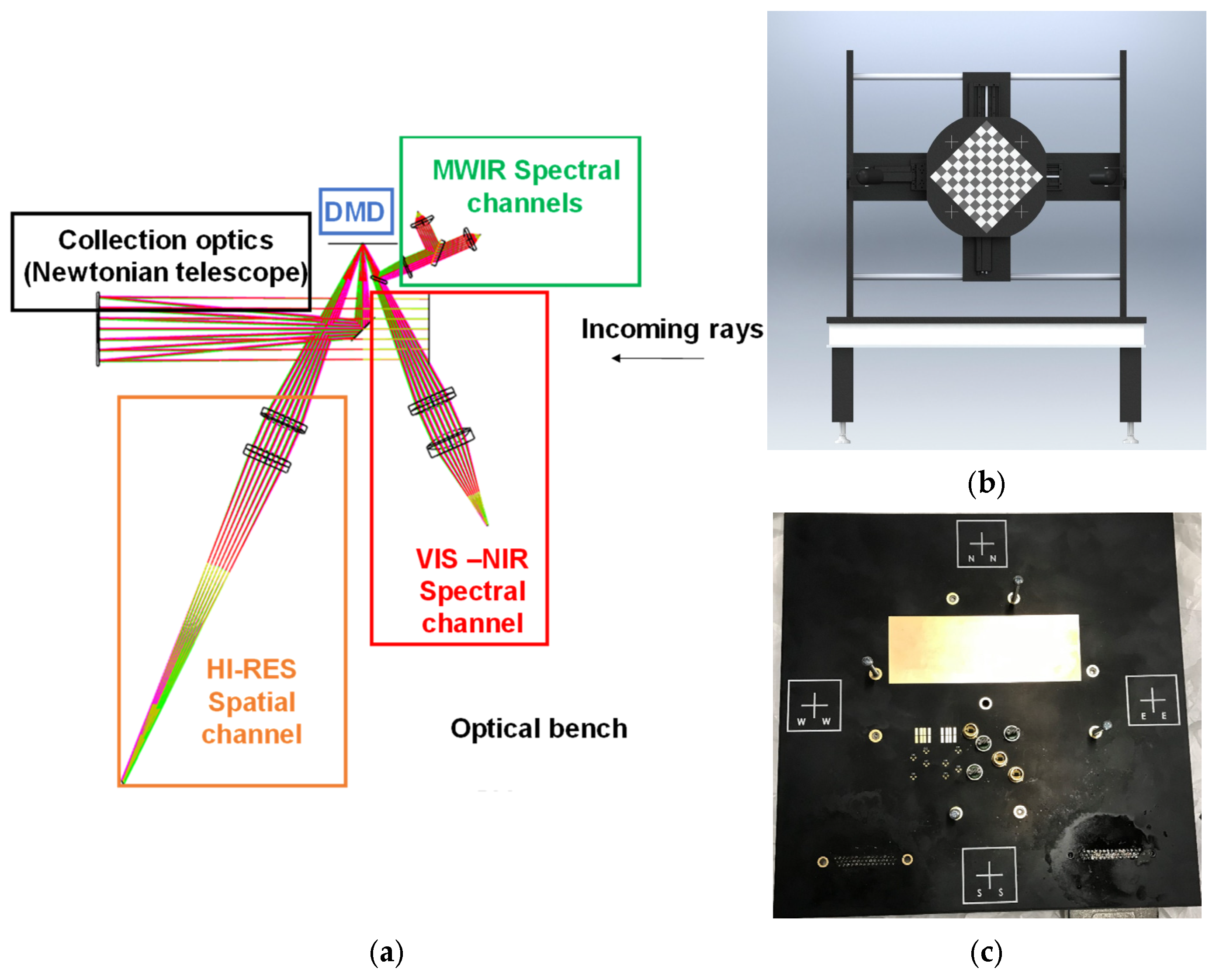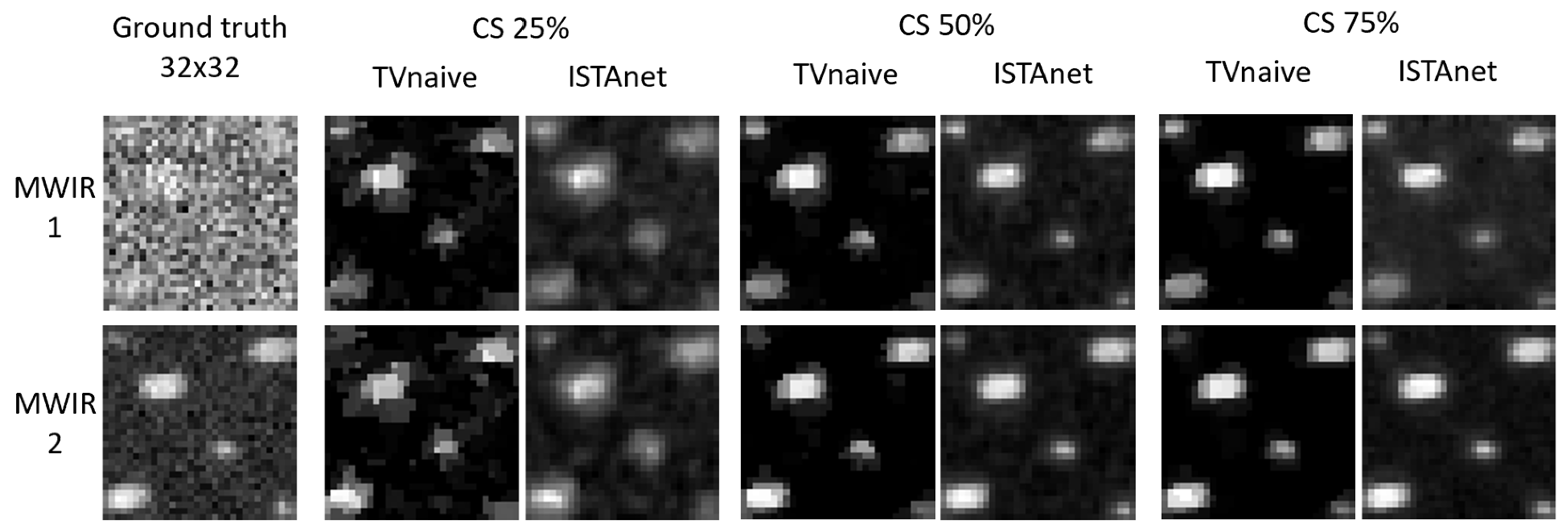First Laboratory Measurements of a Super-Resolved Compressive Instrument in the Medium Infrared †
Abstract
1. Introduction
2. Materials and Methods
3. Results
4. Conclusions
Author Contributions
Funding
Institutional Review Board Statement
Informed Consent Statement
Data Availability Statement
Conflicts of Interest
References
- Candes, E.J.; Wakin, M. An introduction to compressive sampling. IEEE Signal Process. Mag. 2008, 25, 21–30. [Google Scholar] [CrossRef]
- Donoho, D.L. Compressed sensing. IEEE Trans. Inf. Theory 2006, 52, 1289–1306. [Google Scholar] [CrossRef]
- Duarte, M.F.; Davenport, M.A.; Takhar, D.; Laska, J.N.; Sun, T.; Kelly, K.F.; Baraniuk, R.G. Single-Pixel Imaging via Compressive Sampling. IEEE Signal Process. Mag. 2008, 25, 83–91. [Google Scholar] [CrossRef]
- Candes, E.; Romberg, J. Sparsity and incoherence in compressive sampling. Inverse Probl. 2007, 23, 969. [Google Scholar] [CrossRef]
- Borque Gallego, G.; Giriens, L.; Ummel, A.; Roulet, J.C.; Guzzi, D.; Raimondi, V.; Pache, C. Front-window replacement and performance characterization of a commercial digital micro-mirror device for use in the infrared spectrum. In Proceedings of the International Conference on Space Optics—ICSO 2022, Dubrovnik, Croatia, 3–7 October 2022. [Google Scholar] [CrossRef]
- Magli, E.; Bianchi, T.; Guzzi, D.; Lastri, C.; Nardino, V.; Palombi, L.; Raimondi, V.; Taricco, D.; Valsesia, D. Compressive imaging and deep learning based image reconstruction methods in the “SURPRISE” EU project. In Proceedings of the European Workshop on On-Board Data Processing (OBDP2021), Online Event, 14–17 June 2021. [Google Scholar]



| Optical Parameters for the Laboratory Setup of SURPRISE Demonstrator | |
|---|---|
| Parameter | Value |
| Target dimensions (mm) | 30 × 30 |
| Target to lens distance (mm) | 6346 |
| Collection optics focal length (mm) | 350.0 |
| Collection optics focal ratio (F/#) | 4.605 |
| FOV (degrees) | 0.2708 × 0.2708 |
| SLM type | DMD DLP®7000 |
| Micromirrors pitch (μm) | 13.68 × 13.68 |
| DMD area of interest (macro-pixel) | 128 × 128 micromirrors (binned 4 × 4) |
| Maximum nominal super-resolution | 32 × 32 |
| Image (macro-pixel) side on DMD (mm) | 1.751 (13.68 μm × 128 pixels) |
| Lens to image distance (mm) | 370.4 |
| Image dimensions (side) on DMD (mm) | 1.751 × 1.751 |
| Image diameter on MWIR detectors (mm) | <1.0 |
| Image dimensions (side) on VIS-NIR channel fiber entrance plane (mm) | <1 (ensquared energy > 95%) |
| SNR | SR 4 × 4 | SR 8 × 8 | ST 16 × 16 | SR 32 × 32 |
|---|---|---|---|---|
| Channel #1 | 8 | 5 | 1.4 | <1 |
| Channel #2 | 70 | 30 | 14 | 2.5 |
Disclaimer/Publisher’s Note: The statements, opinions and data contained in all publications are solely those of the individual author(s) and contributor(s) and not of MDPI and/or the editor(s). MDPI and/or the editor(s) disclaim responsibility for any injury to people or property resulting from any ideas, methods, instructions or products referred to in the content. |
© 2025 by the authors. Licensee MDPI, Basel, Switzerland. This article is an open access article distributed under the terms and conditions of the Creative Commons Attribution (CC BY) license (https://creativecommons.org/licenses/by/4.0/).
Share and Cite
Guzzi, D.; Bianchi, T.; Corti, M.; González, S.F.; Lastri, C.; Magli, E.; Nardino, V.; Pache, C.; Palombi, L.; Valsesia, D.; et al. First Laboratory Measurements of a Super-Resolved Compressive Instrument in the Medium Infrared. Proceedings 2025, 129, 24. https://doi.org/10.3390/proceedings2025129024
Guzzi D, Bianchi T, Corti M, González SF, Lastri C, Magli E, Nardino V, Pache C, Palombi L, Valsesia D, et al. First Laboratory Measurements of a Super-Resolved Compressive Instrument in the Medium Infrared. Proceedings. 2025; 129(1):24. https://doi.org/10.3390/proceedings2025129024
Chicago/Turabian StyleGuzzi, Donatella, Tiziano Bianchi, Marco Corti, Sara Francés González, Cinzia Lastri, Enrico Magli, Vanni Nardino, Christophe Pache, Lorenzo Palombi, Diego Valsesia, and et al. 2025. "First Laboratory Measurements of a Super-Resolved Compressive Instrument in the Medium Infrared" Proceedings 129, no. 1: 24. https://doi.org/10.3390/proceedings2025129024
APA StyleGuzzi, D., Bianchi, T., Corti, M., González, S. F., Lastri, C., Magli, E., Nardino, V., Pache, C., Palombi, L., Valsesia, D., & Raimondi, V. (2025). First Laboratory Measurements of a Super-Resolved Compressive Instrument in the Medium Infrared. Proceedings, 129(1), 24. https://doi.org/10.3390/proceedings2025129024







